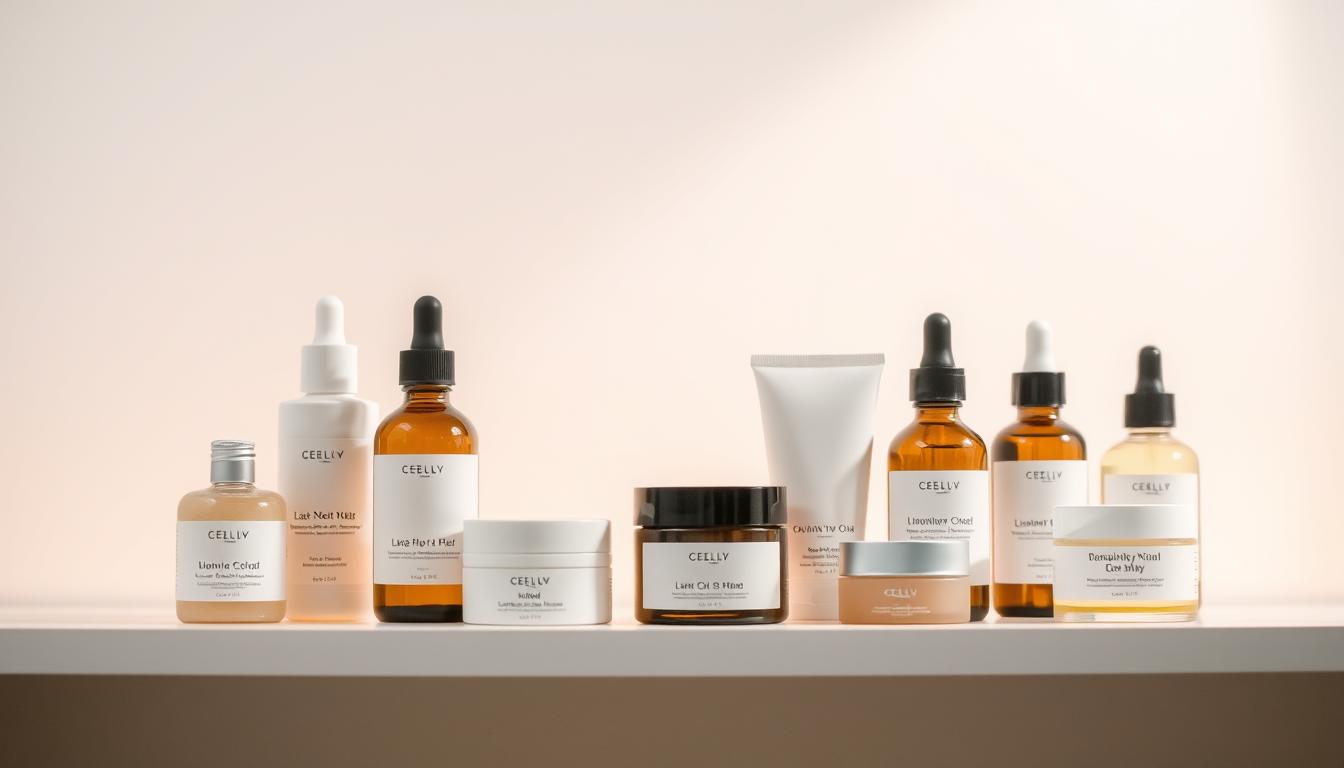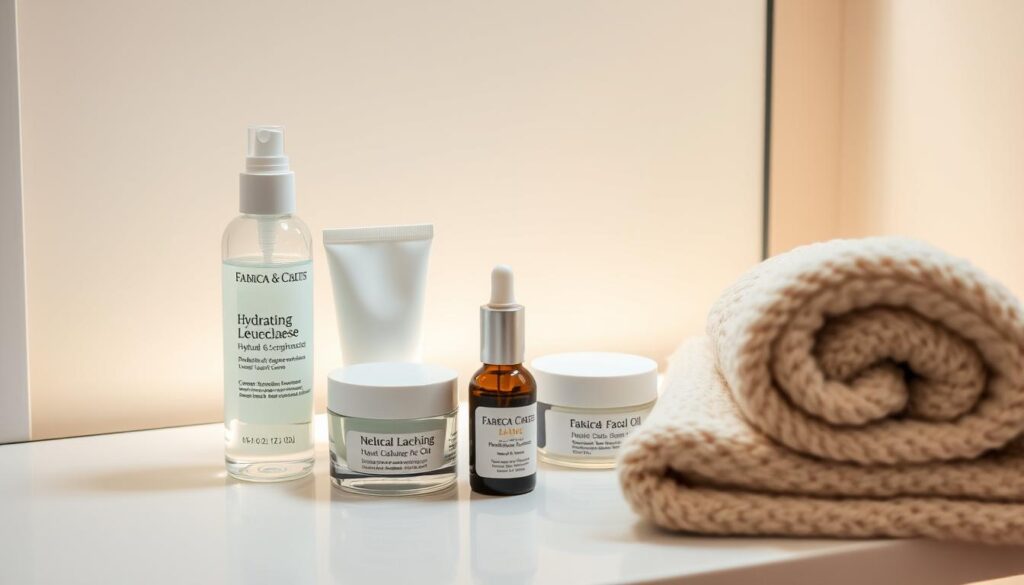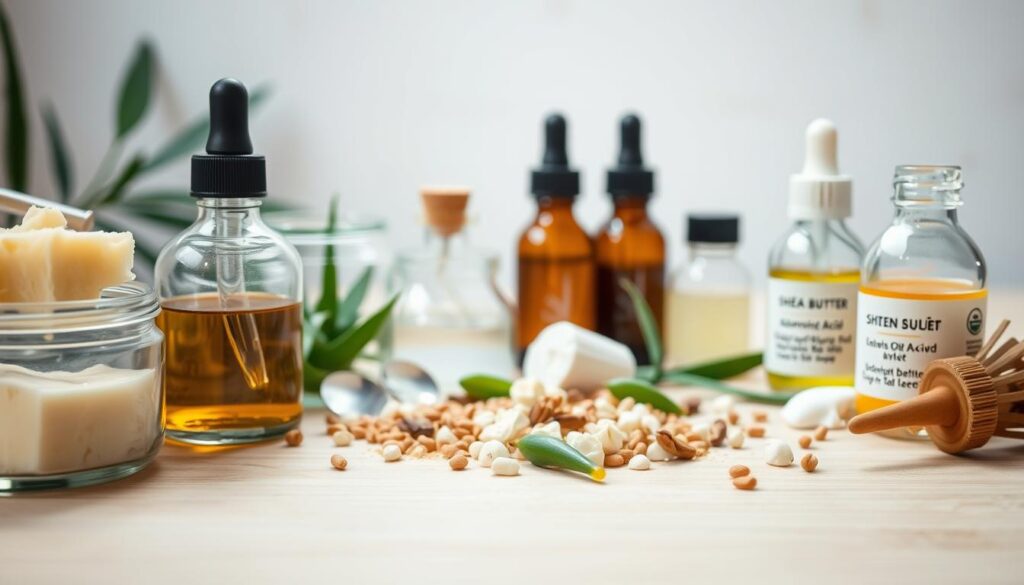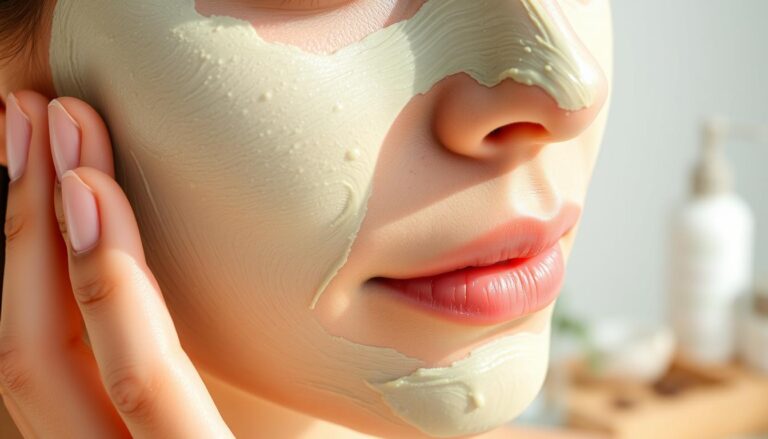At Glowskinhub.com, we believe beauty isn’t just a look—it’s a feeling

How to build a skincare routine for dry skin
Individuals with dry Skin often face challenges in maintaining healthy and hydrated Skin. A well-crafted skincare routine can make a significant difference.
Building a skincare routine for dry Skin requires a deep understanding of the Skin’s needs. It involves using the right products and techniques to lock in moisture and protect the Skin from environmental stressors.
By following a tailored skincare routine, individuals with dry Skin can achieve healthier, more resilient Skin.
Key Takeaways
- Understand your dry Skin type and its specific needs.
- Choose products that are rich in emollients and humectants.
- Use gentle, non-stripping cleansers and moisturisers.
- Exfoliate carefully to avoid stripping the Skin of its natural oils.
- Protect your Skin from environmental stressors.
Understanding Dry Skin: Causes and Characteristics
Understanding the causes and characteristics of dry Skin is crucial for developing an effective skincare routine. Dry Skin, medically known as xerosis, occurs when the Skin’s natural moisture barrier is disrupted, leading to a loss of hydration and potentially causing discomfort.
Common Causes of Dry Skin
Dry Skin can be triggered by a variety of factors, including environmental conditions such as cold weather, low humidity, and exposure to harsh winds. The use of harsh skincare products that strip the Skin of its natural oils can also contribute to dryness. Additionally, underlying health conditions like eczema, psoriasis, or thyroid disorders can increase the likelihood of experiencing dry Skin.

How to Identify If You Have Dry Skin
Identifying dry Skin involves looking out for specific signs and symptoms. Common indicators include a feeling of tightness, especially after washing, flakiness or scaling, and irritation or redness. If your Skin feels rough to the touch or appears dull and lacklustre, it may be a sign that your Skin is dry. Recognising these signs is the first step towards building a dry Skin care plan that works for you.
By understanding the causes and being able to identify dry Skin, you can take the necessary steps towards creating a tailored dry Skin care routine that addresses your specific needs.
The Importance of a Tailored Skincare Routine
Dry Skin demands a tailored skincare regimen to address its unique needs. A well-crafted routine can significantly improve Skin health and appearance.

Why Generic Routines Often Fail Dry Skin
Generic skincare routines often fail to deliver desired results for dry Skin because they do not account for individual Skin characteristics. Using products that are not suited to one’s Skin type can exacerbate dryness, leading to irritation and discomfort. A routine that is not tailored to dry Skin may lack the necessary moisturizing and nourishing elements required to combat dryness effectively.
Benefits of a Customised Approach
A customized skincare regimen offers several benefits for dry Skin. It ensures that the products used are suitable for dry Skin, providing adequate hydration and protection. A tailored approach also allows for adjustments based on the Skin’s response, enabling more effective management of dry Skin conditions. By using the best products for dry Skin routine, individuals can achieve healthier, more resilient Skin.
Essential Components of a Dry Skin Routine
The key to managing dry Skin lies in a carefully designed skincare routine that prioritizes hydration and protection. A dry Skin care routine should be gentle, focusing on nourishing the Skin without stripping it of its natural oils.
Cleansing Without Stripping
Cleansing is a crucial step in any skincare routine for dry Skin. It’s essential to use a gentle cleanser that effectively removes dirt and impurities without drying out the Skin. Look for cleansers that are Fragrance-free and formulated with moisturising ingredients. Avoid harsh cleansers that can strip the Skin of its natural oils, exacerbating dryness.
Hydration and Moisturisation
Hydration and moisturisation are vital components of a dry Skin routine. Using a hydrating toner or essence can help prepare the Skin for further products. Then, applying a moisturiser that contains ingredients like hyaluronic acid or ceramides can help lock in moisture. For dry Skin, it’s beneficial to use products that provide long-lasting hydration.
Protection and Treatment
Protection and treatment are also critical in a dry Skin care routine. Using a broad-spectrum sunscreen daily is essential, even on cloudy days, to protect the Skin from UV damage. Additionally, incorporating treatment products that contain ingredients like ceramides or niacinamide can help repair and strengthen the Skin’s barrier.
Here’s a simple table outlining the essential components and their benefits:
| Component | Benefits |
|---|---|
| Gentle Cleansing | Removes impurities without stripping natural oils |
| Hydration and Moisturisation | Provides long-lasting hydration, improves Skin elasticity |
| Protection and Treatment | Protects from UV damage, repairs Skin barrier |

How to Build a Skincare Routine for Dry Skin: Step-by-Step Guide
A well-structured skincare routine is crucial for managing dry Skin and achieving healthier, more resilient Skin. Building a routine that works for you involves several key steps, from understanding your Skin’s specific needs to selecting the right products.

Assessing Your Specific Needs
The first step in creating a skincare regimen for dry Skin is to assess your Skin’s specific needs. This involves identifying your Skin type, understanding its sensitivity, and recognising any specific concerns such as irritation or flakiness. By doing so, you can tailor your routine to address these issues effectively.
Starting with the Basics
Once you have a clear understanding of your Skin’s needs, you can start building your daily routine for dry Skin with the basics. Begin with a gentle cleanser that preserves your Skin’s natural moisture barrier, followed by a hydrating toner to balance your Skin’s pH. A moisturiser that provides long-lasting hydration is also essential. These foundational products will form the core of your skincare routine.
Gradually Adding Specialised Products
After establishing the basics, you can gradually introduce specialised products to enhance your skincare routine. This might include serums that target specific concerns, such as fine lines or dullness, and exfoliants to gently remove dead Skin cells. It’s essential to introduce these products gradually to avoid overwhelming your Skin and to monitor how your Skin responds.
By following these steps and being patient, you can develop a skincare routine that effectively manages dry Skin and promotes overall Skin health.
Morning Skincare Routine for Dry Skin
A well-structured morning skincare routine is crucial for managing dry Skin effectively. It helps in maintaining the Skin’s natural barrier and preparing it for the day ahead.
Gentle Cleansing Options
Begin with a gentle cleanser that doesn’t strip the Skin of its natural oils. Look for cream-based cleansers or oil cleansers that are formulated for dry Skin. These cleansers help in removing impurities without drying out the Skin.
Hydrating Toners and Essences
After cleansing, use a hydrating toner or essence to add an extra layer of moisture. Products containing hyaluronic acid or glycerin are excellent for dry Skin as they help in retaining moisture.
Serums for Morning Use
For morning use, opt for a lightweight Serum that won’t feel too heavy under your moisturiser and SPF. Antioxidant serums are beneficial as they protect the Skin from environmental stressors.
Moisturisers and SPF
Finally, apply a moisturiser with SPF to lock in the previous steps’ benefits and provide protection against UV rays. Look for a moisturiser that is labelled “non-comedogenic” or “hypoallergenic” to ensure it’s gentle on dry Skin.

| Product Type | Key Ingredients | Benefits for Dry Skin |
|---|---|---|
| Cream-based Cleanser | Glycerin, Ceramides | Gentle, Moisturising |
| Hydrating Toner | Hyaluronic Acid, Glycerin | Retains Moisture, Soothes |
| Antioxidant Serum | Vitamin C, Vitamin E | Protects from Environmental Stressors |
| Moisturiser with SPF | SPF 30 or Higher, Hyaluronic Acid | Protects from UV Rays, Moisturises |
Evening Skincare Routine for Dry Skin
Establishing an evening skincare routine is crucial for individuals with dry Skin to repair and nourish their Skin overnight. As the Skin undergoes natural repair processes during sleep, a well-crafted routine can significantly enhance its health and appearance.
Double Cleansing Method
The double cleansing method is a fundamental step in any evening skincare regimen for dry Skin. It involves first using an oil-based cleanser to remove makeup and impurities, followed by a gentle water-based cleanser to clean the Skin without stripping it of its natural oils.
Treatment Products and Actives
After cleansing, applying treatment products containing active ingredients such as hyaluronic acid, ceramides, or niacinamide can help address specific dry Skin concerns like dehydration, irritation, or loss of barrier function. This step is crucial in a dry Skin care routine.
Rich Night Creams and Sleeping Masks
Using a rich night cream or a sleeping mask can provide an intense dose of moisture and nourishment. These products help lock in previous steps’ benefits and support the Skin’s natural regeneration process during sleep, acting as an effective dry Skin moisturizer.
Optional Facial Oils
For an extra layer of moisturisation, facial oils can be applied on top of night creams or sleeping masks. They help seal in moisture and protect the Skin from environmental stressors.
- Enhance your Skin’s natural barrier
- Provide long-lasting hydration
- Support Skin regeneration overnight

Key Ingredients to Look for in Dry Skin Products
For individuals with dry Skin, selecting products with the right ingredients is a game-changer. A well-crafted skincare routine relies heavily on the quality and type of ingredients used in the products. Understanding these ingredients can make a significant difference in managing dry Skin effectively.

Humectants: Hyaluronic Acid and Glycerin
Humectants are crucial for retaining moisture in the Skin. Hyaluronic acid and glycerin are two of the most effective humectants. Hyaluronic acid can hold up to 1000 times its weight in water, making it an excellent ingredient for dry Skin. Glycerin, on the other hand, helps to attract and retain moisture, leaving the Skin feeling softer and more supple.
Emollients: Ceramides and Fatty Acids
Emollients help to fill gaps between Skin cells, making the Skin feel smoother. Ceramides are particularly beneficial as they repair the Skin’s barrier function, reducing moisture loss. Fatty acids, such as omega-3 and omega-6, also play a vital role in maintaining the integrity of the Skin’s barrier.
Occlusives: Shea Butter and Squalane
Occlusives create a physical barrier on the Skin’s surface to prevent moisture loss. Shea butter is rich in vitamins and fatty acids, providing long-lasting hydration. Squalane, derived from olive oil, is another effective occlusive that protects the Skin without clogging pores.
Ingredients to Avoid
While incorporating beneficial ingredients is crucial, it’s equally important to avoid harsh ingredients that can strip the Skin of its natural oils. Ingredients like alcohol, artificial fragrances, and harsh exfoliants can exacerbate dry Skin. Opting for Fragrance-free and hypoallergenic products can help minimize irritation.
By focusing on products with hyaluronic acid, glycerin, ceramides, fatty acids, shea butter, and squalane, and avoiding harsh ingredients, individuals with dry Skin can create an effective skincare routine that nourishes and protects their Skin.
Best Products for a Dry Skin Routine in the UK
For individuals with dry Skin, finding the right products can be a daunting task, but the UK market offers a plethora of options. When it comes to creating an effective dry Skin care routine, selecting products that cater to your specific Skin needs is crucial.
The UK’s skincare market is filled with a variety of products ranging from budget-friendly to luxury options. Here, we will explore some of the best products available, categorized for ease of selection.
Budget-Friendly Options from Boots and Superdrug
For those on a budget, Boots and Superdrug offer a range of affordable products that are effective for dry Skin. Some notable mentions include:
- Boots Ceramide Cream: A rich moisturiser that helps repair dry Skin.
- Superdrug Hyaluronic Acid Serum: Provides intense hydration.
- Nivea Soft Moisturising Cream: Available at both Boots and Superdrug, it’s a popular choice for dry Skin.
Mid-Range Products from British Brands
British brands offer a range of mid-range products that are both effective and affordable. Some key products include:
- Simple Replenishing Rich Moisturiser: A non-greasy cream that provides long-lasting hydration.
- Aveeno Skin Relief Moisturiser: Helps to soothe dry, itchy Skin.
- E45 Cream: A widely recommended product for dry Skin conditions.
Luxury Skincare Investments Available in the UK
For those willing to invest in their skincare, luxury products offer high-quality ingredients and advanced formulations. Some luxury options include:
- La Mer Moisturising Cream: Known for its hydrating properties.
- Sisley Black Rose Skin Infusion Cream: A rich, luxurious cream for dry Skin.
- Dr. Barbara Sturm Molecular Cream: Provides intense hydration and nourishment.
By choosing the right products from these categories, individuals with dry Skin can create an effective skincare regimen that suits their needs.
Lifestyle Factors That Impact Dry Skin
The health of dry Skin is intricately linked with overall lifestyle choices, including diet, environmental exposure, and stress levels. While a proper skincare routine is essential, it is equally important to consider how daily habits and external factors can either exacerbate or alleviate dry Skin conditions.
Diet and Hydration
A diet rich in omega-3 fatty acids, vitamins, and minerals can significantly benefit dry Skin. Foods such as salmon, avocados, and nuts are excellent for Skin health. Moreover, adequate hydration is crucial; drinking plenty of water helps maintain the Skin’s moisture barrier. It’s also advisable to limit or avoid excessive consumption of dehydrating beverages like alcohol and caffeine.
Environmental Considerations in British Climate
The British climate, often characterized by cold winters and mild summers, can have a significant impact on dry Skin. During the winter, humidifiers can help combat dry air that indoor heating systems can cause. In contrast, summer’s increased sun exposure necessitates careful sun protection with SPF products. Understanding and adapting to these seasonal changes is vital for maintaining healthy Skin.
Sleep and Stress Management
Adequate sleep is essential for Skin health as it allows the body to repair and regenerate Skin cells. Stress, on the other hand, can trigger or worsen dry Skin conditions. Engaging in stress-reducing activities like yoga, meditation, or even simple relaxation techniques can help mitigate this effect. Ensuring a good night’s sleep and managing stress are thus integral parts of a comprehensive dry Skin care plan.
Seasonal Adjustments to Your Dry Skin Routine
Adapting your skincare regimen for dry Skin to the changing seasons is crucial for maintaining healthy, hydrated Skin throughout the year. The British climate, known for its variability, demands a flexible approach to skincare.
Winter Skincare for British Weather
During the winter, the cold weather and lack of humidity can exacerbate dry Skin. Using a gentle cleanser and a rich moisturiser can help lock in moisture. Consider adding a humectant-rich Serum to your daily routine for dry Skin to enhance hydration.
Summer Skincare Adaptations
In the summer, while the Skin may produce more oil, it’s still important to maintain hydration. Lightweight moisturisers and products with SPF are ideal for protecting the Skin without clogging pores. Ensure your skincare routine includes products that balance hydration with sun protection.
Transitional Weather Tips
During transitional periods, such as autumn and spring, the Skin may need adjustments as the weather changes. Exfoliating regularly can help remove dead Skin cells, allowing for better absorption of moisturisers. Be prepared to switch products as needed to keep your Skin balanced.
Common Mistakes to Avoid in Your Dry Skin Routine
Creating an effective skincare routine for dry Skin requires not only knowing what to do but also what to avoid. Many people unintentionally exacerbate their dry Skin condition by making simple yet significant mistakes.
Over-Exfoliation
Exfoliating is an essential step in any skincare routine, but over-exfoliation can strip dry Skin of its natural oils, leading to increased dryness and irritation. Limit exfoliation to once or twice a week and choose a gentle exfoliant suitable for dry Skin.
Using Water That’s Too Hot
Using hot water can strip the Skin of its natural moisture barrier. Instead, use lukewarm water when washing your face or showering to help preserve the Skin’s natural oils.
Skipping Moisturiser
Moisturiser is crucial for dry Skin as it helps to lock in moisture and protect the Skin from environmental stressors. Skipping moisturiser can lead to dryness and irritation, so ensure you apply a moisturiser suitable for dry Skin immediately after cleansing.
Inconsistency in Your Routine
Consistency is key when it comes to skincare. Inconsistently following a skincare routine can lead to suboptimal results. Try to stick to your routine morning and night, and be patient as it may take some time to see improvements.
To further illustrate the common mistakes and their corrections, consider the following table:
| Mistake | Consequence | Correction |
|---|---|---|
| Over-Exfoliation | Increased dryness and irritation | Limit exfoliation to 1-2 times a week |
| Using hot water | Stripped natural moisture barrier | Use lukewarm water |
| Skipping moisturiser | Dryness and irritation | Apply moisturiser after cleansing |
| Inconsistency | Suboptimal results | Stick to the routine consistently |
As skincare expert, Dr. Jane Smith, once said, “The key to managing dry Skin is not just about using the right products, but also about avoiding practices that can further dry out the Skin.” By being mindful of these common mistakes and making adjustments accordingly, individuals with dry Skin can work towards achieving healthier, more hydrated Skin.
“The key to managing dry Skin is not just about using the right products, but also about avoiding practices that can further dry out the Skin.” – Dr. Jane Smith
Conclusion: Nurturing Your Dry Skin for Long-Term Health
Nurturing dry Skin requires a thoughtful and consistent skincare regimen for dry Skin that addresses its unique needs. By understanding the causes and characteristics of dry Skin, you can build a dry Skin care plan that works for you.
A well-crafted skincare routine involves gentle cleansing, hydration, and moisturization. Using a dry Skin moisturizer that is rich in emollients and humectants can help lock in moisture and protect your Skin from environmental stressors.
As you implement your skincare routine, be patient and consistent. It may take some time to see improvements, but with persistence, you can achieve healthier, more resilient Skin. By avoiding common mistakes and adapting your routine to the changing seasons, you can maintain a healthy and balanced complexion.
By taking control of your Skin health and making informed choices, you can enjoy long-term benefits and a more confident you. Start your journey today and watch your Skin transform.





